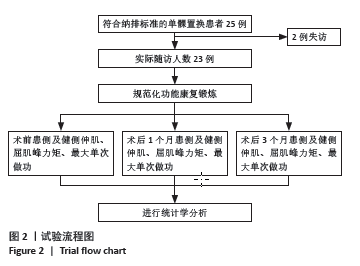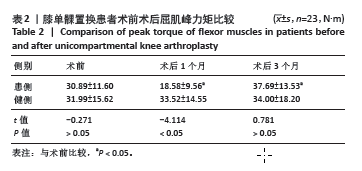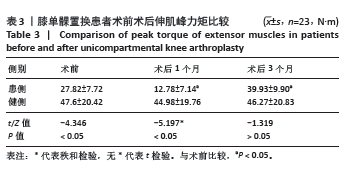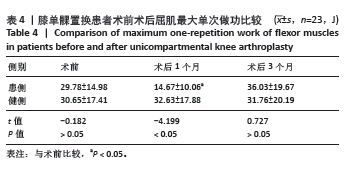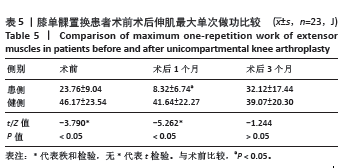[1] 陈瑞楠,陈国茜,刘迅,等. 软骨和软骨下骨与膝骨关节炎关系的研究进展[J]. 中医正骨,2023,35(3):55-60.
[2] SILVERWOOD V, BLAGOJEVIC-BUCKNALL M, JINKS C, et al. Current evidence on risk factors for knee osteoarthritis in older adults: a systematic review and meta-analysis. Osteoarthritis Cartilage. 2015; 23(4):507-515.
[3] DENG M, HU Y, ZHANG Z, et al. Unicondylar knee replacement versus total knee replacement for the treatment of medial knee osteoarthritis: a systematic review and meta-analysis. Arch Orthop Trauma Surg. 2021;141(8):1361-1372.
[4] 彭洪俊,曾羿. 肌肉减少症和骨关节炎相关性研究进展[J]. 中国修复重建外科杂志,2022,36(12):1549-1557.
[5] LESPASIO MJ, PIUZZI NS, HUSNI ME, et al. Knee Osteoarthritis: A Primer. Perm J. 2017;21:16-183.
[6] KOLASINSKI SL, NEOGI T, HOCHBERG MC, et al. 2019 American College of Rheumatology/Arthritis Foundation Guideline for the Management of Osteoarthritis of the Hand, Hip, and Knee. Arthritis Care Res (Hoboken). 2020;72(2):149-162.
[7] GRESS K, CHARIPOVA K, AN D, et al. Treatment recommendations for chronic knee osteoarthritis. Best Pract Res Clin Anaesthesiol. 2020; 34(3):369-382.
[8] ARDEN NK, PERRY TA, BANNURU RR, et al. Non-surgical management of knee osteoarthritis: comparison of ESCEO and OARSI 2019 guidelines. Nat Rev Rheumatol. 2021;17(1):59-66.
[9] 凌晶,涂以济,王识程,等.单髁置换术治疗高龄膝关节骨关节炎疗效的倾向评分匹配研究[J]. 中国骨伤,2023,36(2):151-156.
[10] TIAN S, LIU J, YUAN W, et al. Minimally invasive unicompartmental knee replacement: Midterm clinical outcome. PLoS One. 2017;12(5): e176082.
[11] 陈诊,徐良志,黄志龙,等. 单髁置换术与全膝关节置换术治疗老年膝骨关节炎患者的效果比较[J]. 中国民康医学,2023,35(22): 143-145.
[12] RADIN EL, YANG KH, RIEGGER C, et al. Relationship between lower limb dynamics and knee joint pain. J Orthop Res. 1991;9(3):398-405.
[13] LIIKAVAINIO T, ISOLEHTO J, HELMINEN HJ, et al. Loading and gait symmetry during level and stair walking in asymptomatic subjects with knee osteoarthritis: importance of quadriceps femoris in reducing impact force during heel strike? Knee. 2007;14(3):231-238.
[14] O’HARA BP, URBAN JP, MAROUDAS A. Influence of cyclic loading on the nutrition of articular cartilage. Ann Rheum Dis. 1990;49(7):536-539.
[15] BASDELIOGLU K, MERIC G, PUNDUK Z, et al. Outcomes of isokinetic tests and functional assessment of anterior cruciate ligament reconstruction: Transtibial versus single anatomic femoral tunnel technique. Acta Orthop Traumatol Turc. 2019;53(2):86-91.
[16] 陈鉴冰,叶倩云,朱晓峰. 膝骨关节炎致病危险因素的meta分析[J]. 暨南大学学报(自然科学与医学版),2023,44(4):406-415.
[17] LAWRENCE RC, FELSON DT, HELMICK CG, et al. Estimates of the prevalence of arthritis and other rheumatic conditions in the United States. Part II. Arthritis Rheum. 2008;58(1):26-35.
[18] ATAR S, DEMIRHAN E, CABUK H, et al. Comparison of Pain, Muscle Strength, and Functional Status Following Unicompartmental Knee Arthroplasty, Total Knee Arthroplasty, and Conservative Management of Gonarthrosis. Indian J Orthop. 2022;56(3):464-472.
[19] BARBOUR KE, HELMICK CG, BORING M, et al. Vital Signs: Prevalence of Doctor-Diagnosed Arthritis and Arthritis-Attributable Activity Limitation - United States, 2013-2015. MMWR Morb Mortal Wkly Rep. 2017;66(9):246-253.
[20] KATZ JN, ARANT KR, LOESER RF. Diagnosis and Treatment of Hip and Knee Osteoarthritis: A Review. JAMA. 2021;325(6):568-578.
[21] VINCENT KR, VINCENT HK. Resistance exercise for knee osteoarthritis. PM R. 2012;4(5 Suppl):S45-S52.
[22] BYRNE C, FAURE C, KEENE DJ, et al. Ageing, Muscle Power and Physical Function: A Systematic Review and Implications for Pragmatic Training Interventions. Sports Med. 2016;46(9):1311-1332.
[23] DE ZWART A, DEKKER J, VERBERNE S, et al. Association Between Measures of Muscle Strength and Performance of Daily Activities in Patients with Knee Osteoarthritis. J Rehabil Med. 2022;54:jrm00316.
[24] SINGLA R, NIEDERER D, FRANZ A, et al. The course of knee extensor strength after total knee arthroplasty: a systematic review with meta-analysis and -regression. Arch Orthop Trauma Surg. 2023;143(8): 5303-5322.
[25] 张延杰,黄霄汉,李继超. 股四头肌等长收缩训练治疗髌骨软化症临床观察[J]. 光明中医, 2020,35(9):1336-1338.
[26] 孙文娟,任玉香,杨鑫,等. 膝关节手术术后关节源性肌肉抑制的原理及治疗[J]. 罕少疾病杂志, 2022,29(1):109-112.
[27] JAKOBSEN TL, KEHLET H, HUSTED H, et al. Early progressive strength training to enhance recovery after fast-track total knee arthroplasty: a randomized controlled trial. Arthritis Care Res (Hoboken). 2014;66(12): 1856-1866.
[28] HURLEY MV, JONES DW, NEWHAM DJ. Arthrogenic quadriceps inhibition and rehabilitation of patients with extensive traumatic knee injuries. Clin Sci (Lond). 1994;86(3):305-310.
[29] 李之琛,陈东峰,赵杰,等. 单髁与全膝关节置换术对伸膝肌力影响的差异[J]. 中华关节外科杂志(电子版),2017,11(3):246-249.
[30] KUROWICKI J, KHLOPAS A, SULTAN AA, et al. Improvement in hamstring and quadriceps muscle strength following cruciate-retaining single radius total knee arthroplasty. Ann Transl Med. 2017;5(Suppl 3):S27.
[31] MIZNER RL, PETTERSON SC, SNYDER-MACKLER L. Quadriceps strength and the time course of functional recovery after total knee arthroplasty. J Orthop Sports Phys Ther. 2005;35(7):424-436.
[32] MEIER W, MIZNER RL, MARCUS RL, et al. Total knee arthroplasty: muscle impairments, functional limitations, and recommended rehabilitation approaches. J Orthop Sports Phys Ther. 2008;38(5): 246-256.
[33] THOMAS AC, STEVENS-LAPSLEY JE. Importance of attenuating quadriceps activation deficits after total knee arthroplasty. Exerc Sport Sci Rev. 2012;40(2):95-101.
[34] STEVENS JE, MIZNER RL, SNYDER-MACKLER L. Quadriceps strength and volitional activation before and after total knee arthroplasty for osteoarthritis. J Orthop Res. 2003;21(5):775-779.
[35] POZZI F, SNYDER-MACKLER L, ZENI J. Physical exercise after knee arthroplasty: a systematic review of controlled trials. Eur J Phys Rehabil Med. 2013;49(6):877-892.
[36] WANG XF, MA ZH, TENG XR. Isokinetic Strength Test of Muscle Strength and Motor Function in Total Knee Arthroplasty. Orthop Surg. 2020;12(3):878-889.
|
